Rhaphidophora Decursiva Plant: Care Guide & Common Problems
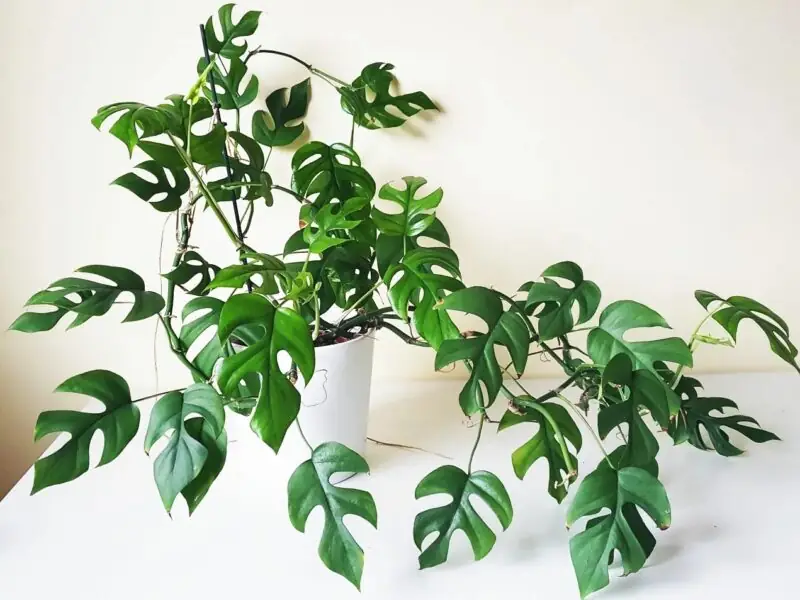
Looking for a tropical houseplant that’s easy to care for and adds some greenery to your indoor space? Look no further than Rhaphidophora decursiva! This stunning plant, native to Southeast Asia, has become increasingly popular among plant enthusiasts in recent years. In this comprehensive care guide, we’ll cover everything from its preferred light requirements to watering frequency. So let’s dive into the world of Rhaphidophora decursiva!
Rhaphidophora Decursiva: Overview
Rhaphidophora decursiva is an evergreen climbing plant belonging to the Araceae family – which also includes other popular species like Monstera and Philodendron. Its leaves are large, oval-shaped, and have distinct splits along their edges, giving them a unique appearance.
This species’ natural habitat includes rainforests throughout Malaysia, Thailand, Indonesia, Vietnam, and Cambodia, where they climb up trees using their aerial roots as support. If provided with appropriate indoor conditions (such as sufficient humidity), these plants can thrive on moss poles or trellises.
Rarity and Popularity
While not necessarily considered rare in its native range, it is commercially available across many online nurseries worldwide. One thing is certain: there’s been no slowing down of people trying out Rhaphidophora decursiva lately because of their exquisite beauty when matured.
Rhaphidophora Decursiva: Background
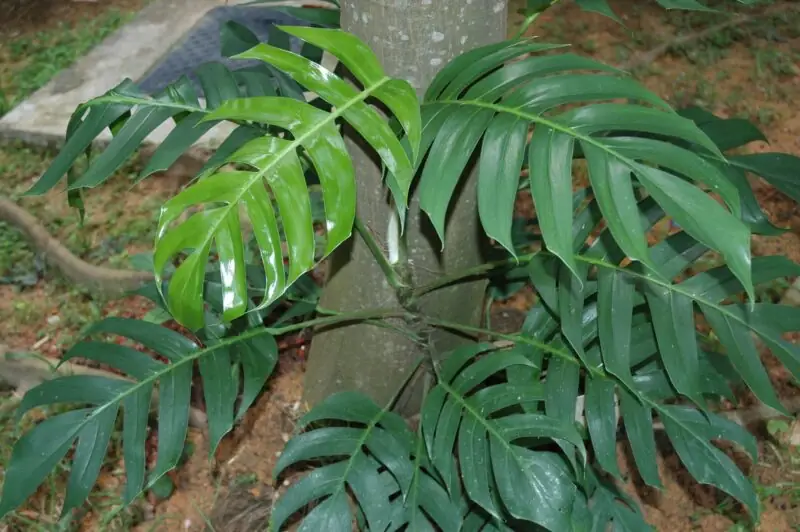
Origin And Habitat
As mentioned earlier, Rhaphidophora decursiva hails from Southeast Asian countries including Malaysia, Thailand, Vietnam, and Cambodia. It is most commonly found growing under tall trees, providing shade during hot days.
These plants are epiphytic climbers, meaning they grow harmlessly upon other foliage without taking any nutrients from the host tree. They achieve this through specialized root structures known as ‘air roots‘. These air roots help them attach to surfaces and absorb moisture from the air.
Rhaphidophora Decursiva vs. Similar Species
At first glance, Rhaphidophora decursiva may look similar to other climbing aroids like Monstera or Philodendron species. While they share some characteristics (such as aerial roots), there are distinct differences in leaf shape and growth habits that set them apart.
Rhaphidophora leaves are usually more oval-shaped with prominent splits along the edges of each leaf, and its petioles have a distinctive reddish-brown color that contrasts well with its green foliage. Monstera leaves tend to be heart-shaped with fewer cuts (fenestrations), while Philodendrons have large, shiny, spade-shaped waxy leaves and are self-heading plants.
Rhaphidophora Decursiva Common Name
This tropical plant is commonly referred to by various names, including Dragon Tail, Rhaphidophora de Rosa, and Rhoadi.
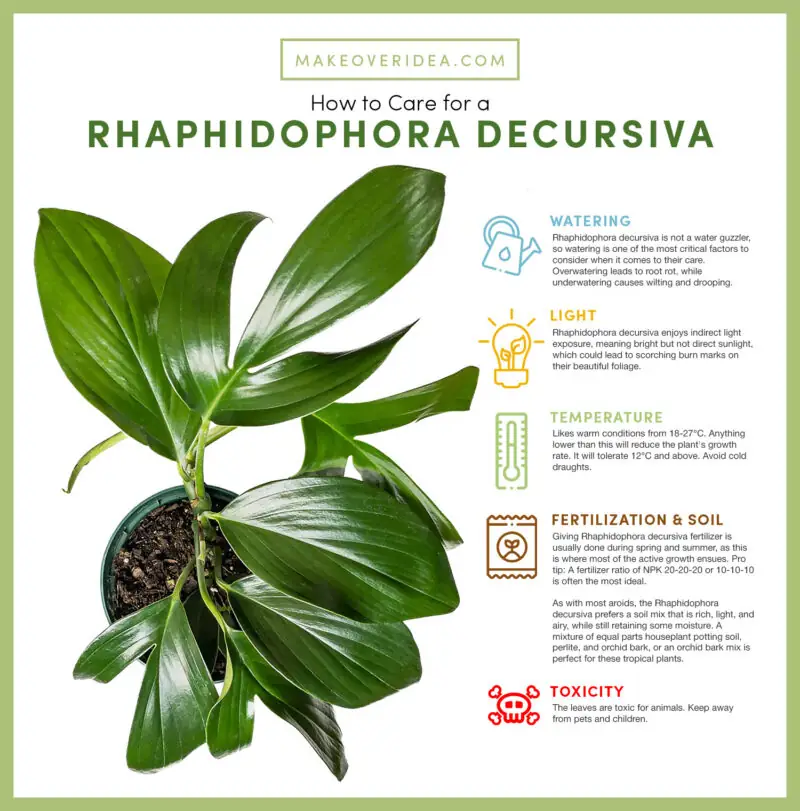
Plant Care Guide: Light Requirements and Sun Exposure
Rhaphidophora decursiva enjoys bright indirect light exposure. Direct sunlight can lead to scorching burn marks on their beautiful foliage and needs to be avoided. Although these plants do best under moderate lighting conditions, enhancing growth rates is possible with grow lights. In summary, place your plant where natural light can penetrate through translucent shades or drapes without causing harm.
During winter months when daylight hours decrease, maintain an optimum distance between lamp sources and the canopy to avoid burning tender new shoot tips.
Care for Rhaphidophora Decursiva: Watering
Rhaphidophora decursiva is not a water guzzler, so watering is one of the most critical factors to consider when it comes to their care. Overwatering leads to root rot, while underwatering causes wilting and drooping.
The best practice is to check the soil moisture level with a finger test or bamboo skewer. Water the plant thoroughly only if the top 2 inches of soil are dry to the touch. If in doubt, wait an additional day before resuming regular monitoring. Water less frequently during winter months due to decreased evapotranspiration rates by plants.
Rhaphidophora Decursiva Care: Temperature and Humidity
As tropical houseplants, Rhaphidophora decursiva prefers warm temperatures ranging from about 65°F (18°C) – 85°F (29°C). They thrive well under humidity levels above average human comfort zones, ranging between 60-80%, averaging around 75%.
When the ambient air feels too dry, mist your plant’s foliage regularly, just enough to add some moisture without causing any standing pools of water on surfaces, as this could lead to fungal diseases developing over time. Furthermore, placing a tray filled with pebbles beneath its pot can increase surrounding humidity levels, keeping your plant happy and healthy.
Plant Care: Soil And Fertilizer
These epiphytes prefer loose, fast-draining soils, hence avoiding heavy, dense, clayey soils which retain excess moisture, leading to oxygen-deficient root systems. Typical mixtures include perlite, sphagnum moss, and bark chips.
Fertilize your Rhaphidophora decursiva every month during spring and summer seasons, using balanced fertilizers containing equal ratios of Nitrogen (N), Phosphorus (P), and Potassium (K), such as 20:20:20. This helps provide vital minerals necessary for vibrant growth spurts throughout the year. Remember never to feed immediately after repotting, as newly established roots need some time to re-establish themselves first.
Enhancing the Beauty: Pruning and Maintenance Tips
Prune older, damaged leaves regularly to promote new growth and improve air circulation around your plant. This helps greatly in preventing pest infestations, fungal infections, or other issues that arise due to overcrowded foliage.
Rhaphidophora Decursiva plants grow very fast, so it’s essential to prune vines at regular intervals if you want a more compact growth look. Lastly, never forget to remove dead or yellowing leaves from time to time, promoting overall plant health.
Going Upward: Moss Pole Support & Climbing
To achieve optimal vertical growth patterns, Rhaphidophora decursiva needs mechanical support systems such as trellises or moss poles. These structures provide stability against gravity when fully grown, thus enhancing the aesthetic appeal of our beloved houseplants.
Trellises allow for trailing stems, while moss poles provide both climbing space and moisture retention properties. Long-stemmed cuttings can be trained using these supports, encouraging aerial roots development on nodes along their lengthening stem, which will eventually anchor themselves into the soil upon finding suitable ground points.
Potting and Repotting Rhaphidophora Decursiva
Potting and repotting your Rhaphidophora decursiva is essential to maintain its health, growth, and appearance. In this section, we will discuss the different aspects of pot selection, the re-pot process, and growing in LECA.
Choosing the Right Pot
Selecting a suitable pot for your Rhaphidophora decursiva is crucial to ensure optimal drainage that prevents root rot or fungal infections. Choose a container that has adequate drainage holes at the bottom; clay pots are an excellent option as they facilitate air circulation around roots.
Another factor to consider when selecting a pot size is choosing one slightly larger than its current container—upgrading from 4 inches to 6-8 inches should suffice as it allows enough space for root expansion without compromising on soil moisture retention.
Re-pot Process and Tips
Re-pot once every two years during spring or summer when new growth begins. Before you start with the re-pot process, prepare a fresh soil mix consisting of peat moss mixed with perlite/sand/orchid bark chips (1:1 ratio).
Remove all unwanted materials like dead stems or leaves present inside the plant; prepare yourself by wearing gloves while working on plants since some species can cause skin allergies due to their sap content.
Carefully extract the existing plant from its current container, ensuring no to damage any fragile roots before transferring it into the newly prepared compost-sand mixture. Make sure it’s planted firmly but do not pack down too hard – gentle pressure works best here!
It’s also important you don’t bury aerial roots underground because they need exposure above ground where the light hits them directly. Aerial roots help provide added support, so cutting these back could be detrimental over time, causing damage such as thinning out foliage near the base.
Finally, water thoroughly after transplanting; keep away from direct sunlight for a few days to help the plant adjust.
Rhaphidophora Decursiva: Rare LECA Approach
Growing your Rhaphidophora decursiva hydroponically is another alternative that’s gaining popularity among houseplant enthusiasts. Growing it in Lightweight Expanded Clay Aggregate (LECA) ensures optimal drainage while providing excellent air circulation around roots, allowing faster growth and moisture retention which promotes healthy foliage.
To grow Rhaphidophora decursiva hydroponically, follow similar steps as mentioned earlier; however, instead of using potting soil, use perlite or coconut coir mixed with LECA pellets at equal ratios.
Remember not to overwater when growing it this way because excess water can cause root rot, leading to other problems like stunted growth, etcetera – always pay close attention!
How to Propagate Rhaphidophora Decursiva
If you’re looking to expand your collection or share the love of Rhaphidophora decursiva with friends, propagation is a great way to do it. Fortunately, this plant is relatively easy to propagate.
Methods of Propagation
There are two main methods for propagating Rhaphidophora decursiva: stem cuttings and air layering. Stem cutting involves taking a cutting from an existing plant and putting it in soil or water until new roots form. Air layering involves making small cuts into the stem and wrapping them with moist moss until they root, then separating that section from the mother plant.
Propagation Tips for Success
No matter which method you choose, there are some tips that can increase your chances of success:
- Choose healthy plants: It’s important to start with strong parent plants as they will produce healthier offspring.
- Use clean tools: Make sure all tools used for propagation (scissors/knives) are sterilized before use by wiping them down with rubbing alcohol.
- Keep humidity high: Adding humidity around your cuttings/air layers encourages rooting, so make sure conditions remain humid throughout the process.
Rhaphidophora Decursiva Cuttings
To take a Rhaphidophora decursiva cutting:
- Locate an area on the stem that is 4 – 6 inches long without any flowers.
- Using sharp scissors, make a snip about one inch below where the leaves attach.
- Remove lower leaves, keeping only the top two sets intact.
- Dip the freshly-cut end in rooting hormone powder if available; tap off excess powder afterward.
- Place the cutting directly into dampened potting soil/mix.
- Cover loosely with a plastic bag, creating a warm environment while aerial roots grow out over the next few weeks.
- Once rooted, move young shoots outdoors gradually, acclimating them to the direct sun. Keep soil moist during the entire propagation process to ensure sturdy and healthy roots are formed.
Rhaphidophora Decursiva: Growth and Appearance
Rhaphidophora decursiva is a beautiful tropical plant that can add flavor to any room or garden with its lush foliage, vibrant colors, and unique appearance.
Growth Rate and Habit
This houseplant has an average growth rate of 6-8 inches per year when properly cared for. It typically grows in an upward direction but occasionally sends out aerial roots which then climb toward support structures such as moss poles or trellises, providing additional height if needed.
Overall growth habit depends primarily on the conditions it’s grown in; more sunlight exposure leads to bushier plants while less light creates taller ones with longer stem lengths between each leaf node. When mature, Rhaphidophora decursiva leaves may reach up to two feet long!
Foliage and Leaf Shape
The foliage of this plant is what makes it so popular amongst enthusiasts around the world: shiny green heart-shaped leaves grow up from the base, extending about six inches long red stems originating at nodes distributed throughout their length set horizontally across vine-like stems.
One unique characteristic of Rhaphidophora decursiva is how glossy its leaves appear, due in part to small dots covering them known as “oil bodies.” Sometimes mottled coppery colorings may be visible upon close inspection.
In terms of size, adult plants have been seen producing large-sized firm green showpiece leaves measuring upwards of twenty-five centimeters wide, resembling giant elephant ears!
Flowering & Fragrance
While not often found blooming indoors, Rhaphidophora decursiva flowers naturally outside, where they produce tiny white flowers that emit a sweet fragrance from spring through summer months, attracting bees, butterflies, hummingbirds, and other insects alike! Unfortunately, these blooms don’t occur frequently when kept inside homes, yet they still offer plenty of aesthetic value as a display of vibrant foliage.
Common Problems with Rhaphidophora Decursiva
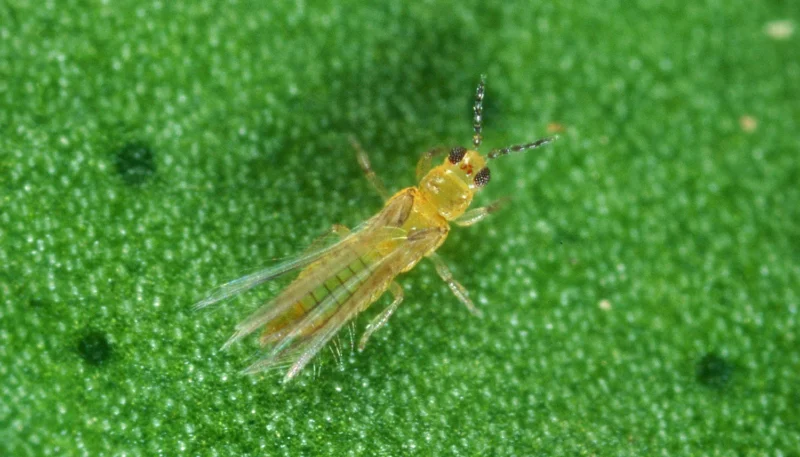
Rhaphidophora decursiva is a relatively low-maintenance plant, but it can still encounter some problems. The following are common issues that you may come across while taking care of your rhaphidophora decursiva:
Pests and Diseases
Like other plants, rhaphidophora decursiva can be affected by pests like spider mites, mealybugs, scale insects, and thrips. These pests feed on the sap of the leaves, which weakens them over time if not controlled.
To prevent infestations or treat an existing one, using neem oil solution could help, as well as wiping down the leaves with soapy water to remove any visible signs of these critters, which will reduce their numbers significantly.
In terms of diseases associated with this plant species, root rot might occur due to overwatering – this condition causes black/brown mushy roots, resulting in wilting foliage. If left untreated for too long, it will lead to death eventually.
If you notice discolored spots or patches on your Rhaphidophora Decursiva’s leaves, then thoroughly inspect them because they might have fungus disease caused by poor air circulation around its environment – increase humidity levels (spray mist) & relocate away from stagnant areas immediately!
Leaf Discoloration and Curling
Leaf discoloration is usually a sign that something isn’t right with your plant – either nutrient deficiency or pest/disease infestation. One example would be yellowed lower leaves due to a lack of nutrients such as nitrogen – fertilize accordingly! Another case would describe brown edges/crispy tips showing up when there’s salt buildup in the soil medium (usually avoided through proper drainage).
Curling Leaves: This phenomenon indicates under/over-watering stressor symptoms! Ensure a thorough watering routine without causing waterlogging, instead providing just consistent moisture levels for optimal growth.
Slow Growth and Other Issues
If you happen to notice that your rhaphidophora decursiva is growing slowly, it may be due to a lack of nutrients or inadequate lighting. Make sure that the plant is getting enough light (preferably indirect) and also check soil moisture levels – keep them consistent!
Another common issue associated with this species would be the yellowing of leaves, which could indicate either nutrient deficiency or disease/pest infestation – treat accordingly by using fertilizers/natural remedies tailored towards eliminating such problems after diagnosis.
Rhaphidophora Decursiva with Long Stem and No Leaves
This condition occurs when the rhaphidophora decursiva grows in low-light environments, resulting in elongated stalks/stems without proper foliage development. In order to avoid this situation, also known as leggy plants, provide more bright & indirect light sources to prevent elongation while ensuring optimal health as well!
Rhaphidophora Decursiva Toxicity
Rhaphidophora Decursiva contains calcium oxalate crystals, which are toxic if ingested, so always take measures not to let children/pets ingest any parts of it – especially chew on its leaves/sap, which contains these irritants leading to bodily discomfort like mouth/throat irritation.
In case anyone comes into contact with the sap, wash affected areas thoroughly but seek medical attention immediately if symptoms persist/increase because they might pose serious harm.
Keep out of reach of kids/pets at all times!
Rhaphidophora Decursiva and Related Species
There are several other aroid species within the Araceae family that have similar features to Rhaphidophora decursiva.
Some notable examples include:
Rhaphidophora vs Tetrasperma
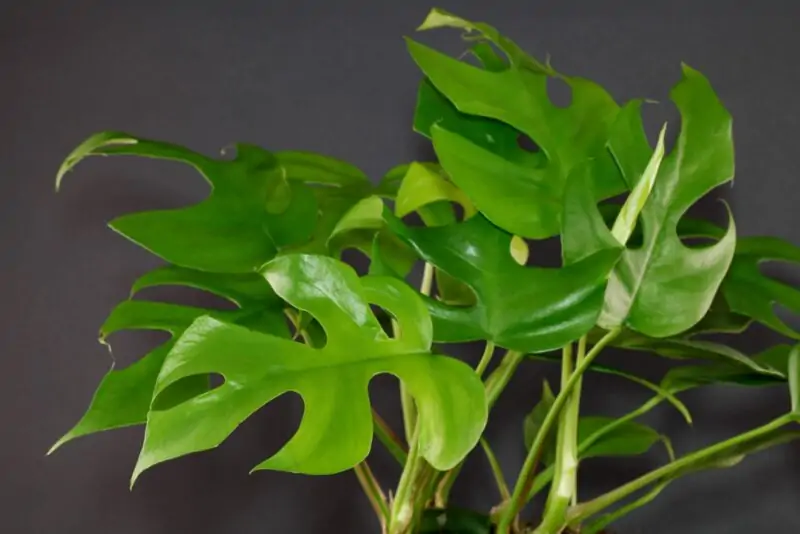
While both share similarities in their leaf shape and appearance, Tetrasperma has much smaller-sized foliage and is a more compact plant. It is also known as “mini monstera” due to shared leaf traits with the Monstera genus!
Rhaphidophora vs Epipremnum Pinnatum
Both have similar growth habits and aerial root systems, though Epipremnum Pinnatum has longer leaves than Rhaphidophora Decursiva and requires less humidity in its environment.
Philodendron Rhaphidophora Decursiva
Philodendron Rhaphidophorum isn’t the same species but shares some common characteristics with Rhaphidophora Decursiva, like their climbing nature and long stem formation.
It’s important not to get confused between these two plants because they differ in terms of geography and origin – Philodendrons come from South America, while R. Decursiva originates from Southeast Asia. They also have distinct features like different foliage and flowering behavior!
Variegated Rhaphidophora Decursiva
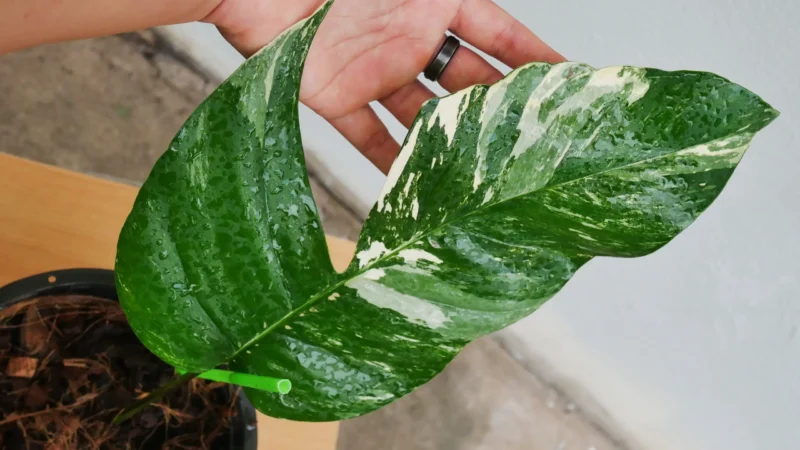
If you’re looking for a unique and eye-catching houseplant, the variegated Rhaphidophora Decursiva is an excellent choice. This plant features striking green and white marbled foliage that can add beauty to any room it’s placed in.
Appearance and Care
Variegated Rhaphidophora Decursiva has leaves with a beautiful blend of emerald green colors swirled with cream or ivory-colored hues along their edges, giving them an elegant touch. The plant grows aerial roots that cling onto surfaces like moss poles or other tall structures, allowing it to climb up.
The care requirements for this rare plant are similar to those of its non-variegated counterpart but require more light because fewer chloroplasts make photosynthesis less efficient in these plants’ white portions.
Ensure you maintain soil moisture without over-watering, as excessive amounts can lead to root rot; stick your finger two inches into the soil mix, and if it’s dry, water thoroughly.
It thrives best at temperatures between 65°F-85°F degrees Fahrenheit (18°C -29°C) and prefers humidity levels above 60%.
Rarity and Availability
Due to its rarity, finding variegated Rhaphidophora Decursiva may be challenging compared with regular ones since they are not mass-produced commercially. This is due to a higher production cost than common varieties frequently sold by nurseries. Keep an eye out for specialized plant shops, online retailers, or plant swaps to find this beautiful and unique variety. However, keep in mind that its rarity may result in a higher price compared to the non-variegated version.
FAQs
Here’s what you need to know about growing this tropical houseplant:
This depends on several factors such as lighting conditions, temperature settings, and level of care provided; however, it typically takes around four years before maturing fully while putting out new growth regularly throughout warmer months once established.
Rhaphidophora Decursiva will thrive best indoors because this Southeast Asia native species cannot withstand cold temperatures, rain, or low humidity found outside in colder climates.
If your Rhaphidophora Decursiva seems unhealthy with yellowing leaves and curled edges, it may require more moisture: don’t forget to keep the soil moist when your plant needs it. Then again, too much water leads to root rot; check the top two inches of soil for dryness, and if they are drier than average, water adequately around the roots.
Rhaphidophora Decursiva is not recommended as an initial houseplant because of its rarity, which increases costs along with different care requirements compared to other plants available in markets. However, it can be grown successfully by enthusiasts who pay close attention, increasing their experience level over time.
Juvenile Rhaphidophora Decursiva has smaller foliage than mature plants, growing about six inches long, while adult ones grow about ten times this length, making them perfect candidates for indoor spaces! Be patient during growth stages since it takes years before they become full-fledged members amongst their peers.
Conclusion
Growing variegated Rhaphidophora Decursiva can be challenging yet rewarding due to its striking marbled appearance adding uniqueness; placing this tropical indoor plant enhances any room decor when given proper light conditions and moisture levels without excesses leading to health problems like pest attacks or diseases caused by fungal infections, etc., located throughout warmer months!
Final Care Tips:
- Keep away from drafts near windows and doorways causing temperature changes affecting the plant’s sensitive nature (or shield against direct sunlight);
- regularly clean off dust gathered on surfaces using a damp cloth, avoiding chemicals that could harm the pores on the delicate leaves of your Rhaphidophora Decursiva.